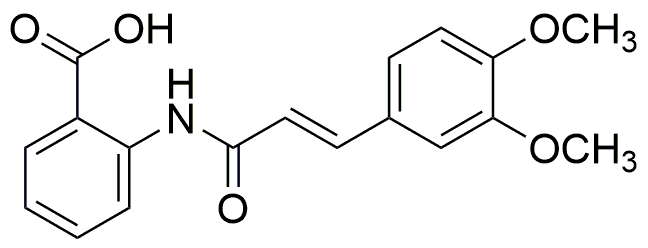Tranilast is widely utilized in research focused on:
- Anti-allergic Treatments: Commonly used in the management of allergic conditions such as asthma and rhinitis, providing relief by inhibiting the release of histamines.
- Fibrosis Management: Effective in treating conditions like keloids and hypertrophic scars by reducing collagen synthesis, making it valuable in dermatology.
- Anti-inflammatory Applications: Demonstrates potential in reducing inflammation in various diseases, including chronic inflammatory conditions, offering a therapeutic option for patients.
- Cardiovascular Health: Research indicates its role in protecting against vascular damage, which can be beneficial in preventing heart diseases.
- Research in Cancer Therapy: Investigated for its potential to inhibit tumor growth and metastasis, making it a subject of interest in oncology studies.
General Information
Properties
Safety and Regulations
Applications
Tranilast is widely utilized in research focused on:
- Anti-allergic Treatments: Commonly used in the management of allergic conditions such as asthma and rhinitis, providing relief by inhibiting the release of histamines.
- Fibrosis Management: Effective in treating conditions like keloids and hypertrophic scars by reducing collagen synthesis, making it valuable in dermatology.
- Anti-inflammatory Applications: Demonstrates potential in reducing inflammation in various diseases, including chronic inflammatory conditions, offering a therapeutic option for patients.
- Cardiovascular Health: Research indicates its role in protecting against vascular damage, which can be beneficial in preventing heart diseases.
- Research in Cancer Therapy: Investigated for its potential to inhibit tumor growth and metastasis, making it a subject of interest in oncology studies.
Documents
Safety Data Sheets (SDS)
The SDS provides comprehensive safety information on handling, storage, and disposal of the product.
Product Specification (PS)
The PS provides a comprehensive breakdown of the product’s properties, including chemical composition, physical state, purity, and storage requirements. It also details acceptable quality ranges and the product's intended applications.
Certificates of Analysis (COA)
Search for Certificates of Analysis (COA) by entering the products Lot Number. Lot and Batch Numbers can be found on a product’s label following the words ‘Lot’ or ‘Batch’.
Numéro de catalogue
Numéro de lot/série
Certificates Of Origin (COO)
This COO confirms the country where the product was manufactured, and also details the materials and components used in it and whether it is derived from natural, synthetic, or other specific sources. This certificate may be required for customs, trade, and regulatory compliance.
Numéro de catalogue
Numéro de lot/série
Safety Data Sheets (SDS)
The SDS provides comprehensive safety information on handling, storage, and disposal of the product.
DownloadProduct Specification (PS)
The PS provides a comprehensive breakdown of the product’s properties, including chemical composition, physical state, purity, and storage requirements. It also details acceptable quality ranges and the product's intended applications.
DownloadCertificates of Analysis (COA)
Search for Certificates of Analysis (COA) by entering the products Lot Number. Lot and Batch Numbers can be found on a product’s label following the words ‘Lot’ or ‘Batch’.
Numéro de catalogue
Numéro de lot/série
Certificates Of Origin (COO)
This COO confirms the country where the product was manufactured, and also details the materials and components used in it and whether it is derived from natural, synthetic, or other specific sources. This certificate may be required for customs, trade, and regulatory compliance.

